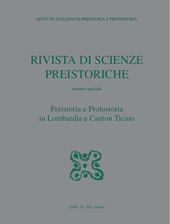L'attività di tutela e di ricerca sull'arte rupestre e sui contesti archeologici in Valle Camonica condotta dalla Soprintendenza Archeologica della Lombardia tra il 2005 e il 2016
P. 367-375
Among the institutional activities of the Superintendencies, protection and research are two fundamental and essential points of reference for the preservation of the cultural heritage of a territory. The Valle Camonica is a real cultural landscape where Man and Environment have constantly interacted. This intimate connection found its more evident and concrete expression in the widespread presence of engraved rocks inscribed in the World Heritage List UNESCO in 1979 because they show not only the history of the ancient inhabitants of the Valley but the history of humankind. Since 2005, when the UNESCO Site Management Plan was carried out by the Superintendence for Archaeological Heritage of Lombardy, a series of Plans have been set up for the enhancement of parks, sites and routes, for archaeological research, for maintenance and restoration, including the total monitoring of sites.
Several interrelated projects have been planned and achieved with the collaboration of Region Lombardia and local authorities to increase knowledge and protection of the rock art, a widespread heritage realized over several periods of human history. The Project “Monitoring of, and Good Practices for, the protection of UNESCO Site 94 “Rock art in Valle Camonica”, funded by UNESCO Law 77/2006, Financial Year 2010, and carried out between 2012 and 2014, had as its main objective the monitoring of the rock art heritage of Valle Camonica with the IRWEB cataloguing system and the creation of a GIS, used for the evaluation of territorial projects. At the same time, the Superintendence started in 2013 and 2015 new projects with the Law 77/2006 for the preservation of rocks engraved, collecting data from historical archives and for the study of lichens and biodeterioration phenomena according to new methodologies of intervention.
Interesting results also come from the study of rock paintings combined with geological explorations to identify common elements and peculiar features of the stone and the spatial and geographical distribution of such art expressions.As far as archaeological research is concerned, the excavations of archaeological sites, since 2014 exhibited in the MUPRE-National Museum of Prehistory of the Valle Camonica at Capo di Ponte, finally allowed in 2015 to extend the Outstanding Universal Value (OUV) of the UNESCO site, relating rock art to the places where man lived, worked, buried, and carried out rites and ceremonies. [Publisher's text]
Forma parte de
Rivista di scienze preistoriche : LXXII, supplemento, 2022-
Artículos del mismo número (disponibles individualmente)
-
Información
Código DOI: 10.32097/1181
ISSN: 2282-457X


